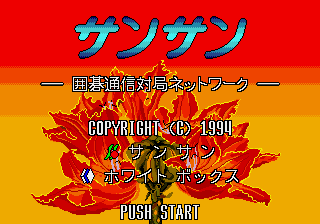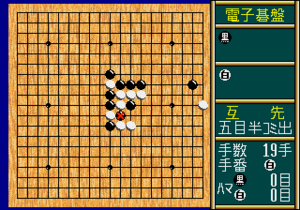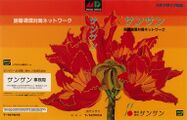Difference between revisions of "Sansan"
From Sega Retro
m (→External links) |
m (Text replacement - "==External links==" to "==Technical information== ===ROM dump status=== {{romtable| }} ==External links==") |
||
| Line 33: | Line 33: | ||
| cover=Sansan md jp cover.jpg | | cover=Sansan md jp cover.jpg | ||
| cart=Sansan cart.jpg | | cart=Sansan cart.jpg | ||
| + | }} | ||
| + | |||
| + | ==Technical information== | ||
| + | ===ROM dump status=== | ||
| + | {{romtable| | ||
| + | |||
}} | }} | ||
Revision as of 09:12, 1 November 2019
| Sansan | ||||||||||
|---|---|---|---|---|---|---|---|---|---|---|
| System(s): Sega Mega Drive | ||||||||||
| Publisher: Sansan | ||||||||||
| Developer: White Box | ||||||||||
| Peripherals supported: Sega Mega Modem | ||||||||||
| Genre: Table | ||||||||||
| Number of players: 1-2 | ||||||||||
|
This teeny-tiny article needs some work. You can help us by expanding it.
Sansan (サンサン) is an online service allowing people living in Japan to play the abstract strategy board game Go with other subscribers over the internet on a Windows PC. However, at its launch in 1994, a version for the Sega Mega Drive was also made available. This version of the game allows players who have a Sega Mega Modem to connect over a 33.3kbps or ISDN line to play other members who have a Sansan ID. However, as of 2011, there are no known Mega Drive-compatible Sansan servers. A local two-player version of the game is also included for play.
For whatever reason, the Mega Drive version did not last very long — it is one of the rarest and most sought-after Mega Drive games; Sega of Japan's official archive doesn't list it (despite Sansan Co., Ltd. having T-series code T-147) and a ROM was not dumped until February 2011. The Windows PC version of the service continues to this day.
Contents
Gameplay
Two players, Black and White, take turns placing a stone (game piece) of their own color on a vacant point (intersection) of the grid on a Go board by pressing ![]() . Black moves first. The official grid comprises 19×19 lines. Vertically and horizontally adjacent stones of the same color form a chain (also called a string) that shares its liberties (see below) in common, cannot subsequently be subdivided, and in effect becomes a single larger stone. Only stones connected to one another by the lines on the board create a chain; stones that are diagonally adjacent are not connected. Chains may be expanded by placing additional stones on adjacent intersections, and can be connected together by placing a stone on an intersection that is adjacent to two or more chains of the same color.
. Black moves first. The official grid comprises 19×19 lines. Vertically and horizontally adjacent stones of the same color form a chain (also called a string) that shares its liberties (see below) in common, cannot subsequently be subdivided, and in effect becomes a single larger stone. Only stones connected to one another by the lines on the board create a chain; stones that are diagonally adjacent are not connected. Chains may be expanded by placing additional stones on adjacent intersections, and can be connected together by placing a stone on an intersection that is adjacent to two or more chains of the same color.
A vacant point adjacent to a stone is called a liberty for that stone. Stones in a chain share their liberties. A chain of stones must have at least one liberty to remain on the board. When a chain is surrounded by opposing stones so that it has no liberties, it is captured and removed from the board. Players are not allowed to make a move that returns the game to a previous position. This rule, called the ko rule (from the Japanese 劫 kō "eon"), prevents unending repetition. Instead of placing a stone, a player may pass. This usually occurs when they believe no useful moves remain. When both players pass consecutively, the game ends and is then scored.
Magazine articles
- Main article: Sansan/Magazine articles.
Physical scans
Technical information
ROM dump status
| System | Hash | Size | Build Date | Source | Comments |
|---|
External links
References
- ↑ http://sansan.co.jp/company.html (Wayback Machine: 2001-03-11 15:25)


